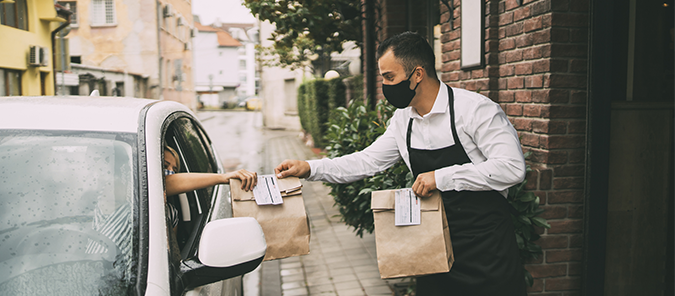
According to a McKinsey report, since the pandemic began, 75 percent of U.S. consumers have tried a new shopping behavior in response to economic pressures, store closings, and changing priorities.[1] That was made possible by retailers willing to undertake new technology deployments to address changing needs.
Yet as Luke Mueller, senior internal communications platform specialist at Thomson Reuters, explained, “When introducing new technology or processes, you have to think about the customer. Consider how the technology or the transactions work from the customer’s point of view. If it adds time to the transaction, or it’s hard for employees to use and it affects their attitude, that ruins the customer experience.”
Here are three top retail trends to gain traction during the pandemic for their ability to meet specific needs and improve the customer experience.
- Curbside Pickup and Buy Online, Pickup In-Store Options
The concept of “buy online, pick-up in store” (BOPIS) is not new. Retailers have been applying the approach, especially during the holidays, to better serve customers looking for faster and more efficient shopping experiences. With the pandemic, BOPIS (and more specifically “curbside pickup”) became one of the preferred ways consumers could shop safely. According to Adobe Analytics data (via DigitalCommerce360), BOPIS orders increased by 208% in April 2020 compared to the same time in 2019.
Over the many months that stores operated during lockdown, curbside pickup emerged as a standard offering – as did higher expectations surrounding the experience. One survey found shoppers chose to avoid BOPIS at a retail location if they discovered:[2]
- Items unavailable at the store (25.2%)
- A long line at pickup (11%)
- General lack of convenience in BOPIS offerings (10.5%)
- Lack of safety measures in BOPIS operations (6%)
All of these missteps can add up to lost sales if a retailer is unable to deploy technologies and solutions to support smooth and efficient transactions, like real-time inventory systems or an integrated e-commerce site.
[Download our ebook on BOPIS here.]
- QR Codes and Contactless Service
It might surprise you to learn that the Quick Response (QR) Code was developed in 1994, by Masahiro Hara, of Denso Wave, a Japanese corporation.[3] Yet even after smartphones incorporated barcode scanning technologies adoption rates were low. It wasn’t until 2020 and the pandemic and when Square incorporated the codes into digital ordering and payment systems that QR codes finally took hold. With QR codes and contactless commerce and cashless transactions, retailers had a way to protect their staff and customers.
Now that the hurdle of adoption is behind us, these solutions are helping to create more robust on-site digital experiences, increasing customer engagement and upsell opportunities — without requiring additional staff. QR Codes allow customers to research product or pricing information and access curated content – such as videos depicting specific product uses, features, and benefits all through content accessible via the scanned QR tag.
What retailers may not realize is that QR codes can provide valuable data analytics to optimize customer insights and serve as an incentive for customers to download the brand’s mobile app. Once downloaded, the app can send push notifications to engage customers through special offers and promotions.
- Bring Your Own Device Strategies
Even before the pandemic struck and we had to rethink the downside of shared payment screens or tablets, the “bring your own device” (BYOD) trend was growing. It’s especially appealing for retailers looking to provide staff with seamless access to different store workflows. Not having to wait at a cash register for example, helps essential tasks get done quickly in an environment where expediency matters.
It appears the rise in BYOD is just beginning. According to Mordor Intelligence, BYOD is expected to see 15% compound annual growth from 2021-2026, in part due to 4G and 5G networks and an increasing demand for smartphones.[4] And big retailers are leading the way. Retail Information Systems recently reported that Walmart is giving 740,000 associates smartphones with a custom mobile app, Me@Walmart, to simplify daily work tasks, serve customers, and plan for life outside of work.
Eric Schauer, senior IT director and portfolio manager for Luxottica Sun Brands, said retailers should take time to develop their BYOD strategy and consider what they want employees to be able to do on their devices – just like Walmart did. Will they perform timekeeping duties or access and manage their work schedules while away from the store? Will they be able to place orders, check inventory, and process payments? How will the brand handle security and privacy issues? And, who will be responsible for device repair or replacement, in the event it dies or is damaged?
Building a strategy in advance saves time and frustration. Because while BYOD can be beneficial, if it’s deployed incorrectly Mr. Schauer noted, it is difficult to halt a program and redeploy at a later date.
From getting products into customers’ hands to improving health and safety protocols, retailers found innovative ways to solve Covid-related challenges. By deploying technology in new and creative ways– even some technologies that had been underappreciated for years – retailers revamped their operations and identified how to safely serve their customers. What started as a quick-thinking response to the pandemic created elevated experiences for customers – trends that are here to stay.